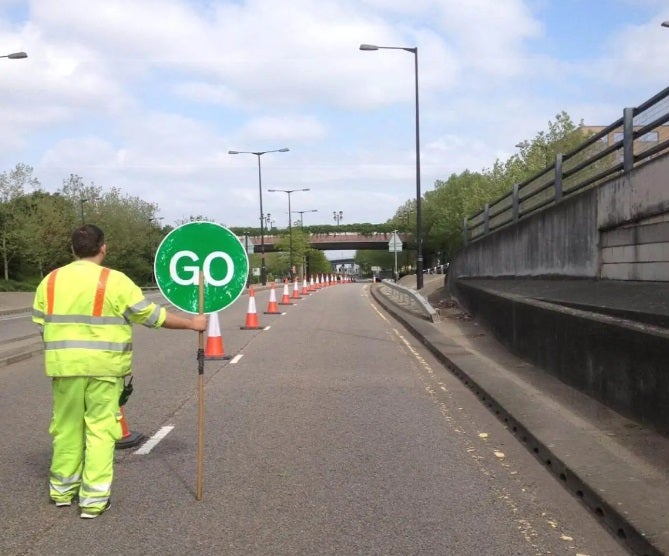
A guide to traffic management
Getting to grips with traffic management is a crucial part of any location filming and, with more than 30 years’ experience in the industry, we asked Bill Stanley of On Set Traffic Management to offer his advice on navigating the planning and logistics.
On Set Traffic Management (OSTM) has some impressive credits, including Mr Bates vs The Post Office, Silent Witness and a Robbie Williams project that involved closing down Regent Street. Stanley’s guidelines are as follows:
The start of the Traffic Management (TM) process
- When choosing your potential location, your location team should first contact the borough filming authority or their fixer to discuss gaining permission for a traffic control. This can ensure that your timings are in line with the region’s traffic application acceptance times
- When finding a TM service provider “preferably via your SLM” [supervising location manager] it’s recommended that you choose a company that specialises in the film, TV and promotional industry, who will properly assess your requirements and thereafter determine the traffic control layout
- When complicated controls are expected, for example for scenes involving complex manoeuvres, it could be advisable to have a TM representative attend the technical recce, or have a prior meeting with your location manager (LM) on location before your chief meeting commences
Paperwork and timeframe
- After a short time you will receive (from your chosen TM service provider) the TM control plan, method statement and risk assessment and proof of the (usually required £10m) TM insurance – all of which you can use directly when liaising with the borough on your traffic control application.
- Plan early. Although the traffic control application/acceptance time varies between boroughs, the type of control can also influence the timing for your acceptances, therefore early planning is paramount.
Bear in mind that other stipulations and considerations may affect your application such as high traffic-frequency areas and the applied-for control times, as well as TFL bus routes. Although, with a good lead time, the correct communications and guidance, it’s likely that you will secure your first choice filming requirements.
However, if an authority determines that your chosen location isn’t suitable, for example due to the complexity of the location or whether or not a road must be closed off completely for your type of activities, the fixer may be able to recommend an alternative approach, or even a new filming area.
However, some boroughs do require a traffic plan application showing your full potential requirements before negotiations can be further carried out between you and the borough.

Fees
- Independent of the control plan and traffic management fees, the cost of submitting plans “for a traffic control, pedestrian control or kit surrounds”, the application fees should be discussed with the related film office or fixer; these costs may differ between boroughs. The prices charged from one specialist TM operator to another can vary, and so too may the detail within the overall service provided.
The shooting schedule
- When the date and control areas for your traffic management requirements have been applied for and accepted by the borough, these are not changeable without prior notice. Control plan changes and acceptance with the related authorities are legally binding, and if not carefully adhered to, could void insurances and damage reputations and ongoing relations for the Industry.
It is mostly understood that filming schedules and timings may change due to unforeseen circumstances, and to avoid your running out of time on the day “of which the applied for start and end times are a legal factor” you should include potential overrun time allowances for controls.
Furthermore, it may also be ruled by a borough that controls cannot commence during high-frequency traffic times or school run times; in addition when also required “that public transport vehicles will not be held when approaching/in view prior to scenes commencing”.
If viable, these communications can be shown within the TM method statement notes, and further discussed via your own communications, prior to, and when submitting a TM application.
Prior communications and crucial kit
- When all of the relevant permissions are in place, the TM company should be notified of your final times and shooting schedule, and informed of any minor changes that have been made, before shooting begins.
It is also essential that cast and crew are informed when filming is going to commence under a traffic control, and that your location teams have all of the included marshal points properly determined and the related personnel are briefed.
It is also crucial that that the correct kit is available, for example, high-vis jackets and fully-functional production radios must be accessible for your key control assistants prior to controls commencing, and that any production requirements regarding health and safety (H&S) have been properly established and communicated internally.
Communication on the day
- Key crew members on set should have access to the traffic control plan, possibly in hard copy form and, before traffic controls commence, the TM supervisor should have prior communication with the 1st AD to discuss matters such as traffic control points/areas and that procedures in the event of an emergency are clear.

After this is properly communicated, the 1st AD can again relay any relevant information to the rest of the crew, or for example announce that the following scene involves traffic controls, and for the crew to be vigilant within their surroundings! As of course, not all road users adhere to the law, or conduct themselves appropriately.
Additionally, it is essential that all TM operatives are provided with fully-functional production radios prior to any required controls.
Production radios
- The TM operatives should be provided with radios on the same frequency as the production company so they can communicate with key crew (such as the 1st AD). Furthermore, the lead TM operative/supervisor should be provided with two radios, one to have communication with the 1st AD on the main shooting channel, and one to speak with the other TM operatives on a designated TM channel.
Furthermore, should a radio fail, it’s crucial that a replacement battery or radio is available to be exchanged without delay, as clear communications are of course vital to traffic controls and safety.
TM is not security, and security and marshals are not traffic management
- It’s important to establish that a filming-specialist traffic management team should not be confused with filming security, marshals or assistants, therefore, other than when controlling a road closure.

If the operatives are not needed to assist traffic passing camera, crew or equipment, or to supervise/control traffic, they should be relieved of their position until they’re needed for following scenes, in addition provided reasonable notice to be back in position, focused, ready and standing by again in good time.
Moreover, only licensed, uniformed and specifically trained and capable traffic operatives can legally control traffic and communicate verbally and visually with vehicles being held or motorists passing through.
Furthermore, make sure that your communication with the TM supervisor is properly established, for example that a single key crew member gives and receives traffic control communications and that others do not get involved at all. It is vital that TM ops can concentrate on the task at hand, and therefore are not requested to deal with pedestrian traffic, unless when specifically designated to manage pedestrians only, for example when working under a pedestrian management plan as provided by a related TM company
- Within the confines of the traffic control areas, pedestrians, non-compliant cyclists and motorists attempting to move a parked or stationary vehicle should be monitored and assisted by production personnel.
Production marshals and security
Those assisting such essential activities should be properly experienced in those communications and recognisable, with a radio and in a high-vis waistcoat. Moreover, proper management and apparatus to stop cyclists within cycle lanes should be included within a control plan and therefore those controls must be implanted by a traffic operative for legal validity.
Hi-vis jackets for crew
- If the crew are working on/near a highway during daylight or darkness hours, it is advised that a high-visibility waistcoat to standard EN ISO 20471 should be provided and enforced by production/locations.
Filming at night under a traffic control
- Mechanical traffic lights are usually required when filming at night, when special circumstances require or when stipulated by the borough. Whenever hand-held ‘stop’ and ‘go’ signs are permitted in darkness, those signs have to be highlighted with work lights across the whole sign face, although their use depends on the lack of natural daylight or at other times when mechanical traffic lights are sometimes not imposed.
For further information and essential pre-application guidance and for an established, tried and tested traffic management service from On Set, click here.
*Please seek legal advice from your legal representatives regarding your own responsibilities and legal requirements relating to traffic management or other related activities on location.
With many thanks to Bill Stanley of On Set Traffic Management for his guidance and expertise.
All images via On Set Traffic Management.

Share this Article











